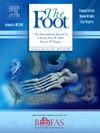渐进性塌陷足病三角肌弹簧复合体重建新技术
Q2 Health Professions
引用次数: 0
摘要
成人获得性扁平足畸形(AAFD)是一种进行性疾病,其特征是内侧足弓塌陷,通常由胫骨后腱功能障碍或三角肌弹簧韧带功能不全引起。柔性型2型AAFD导致肱骨周围半脱位和不稳定。三角肌和弹簧韧带复合物在足部稳定性中起着关键作用。目前的手术治疗包括韧带重建、肌腱转移和截骨术,但对晚期病例的综合治疗方法有限。本研究比较了两种新技术-四边形和三角形修复-使用纤维带或金属丝重建三角肌弹簧复合体,并结合内侧移位跟骨切开术(MCDO)治疗II期AAFD。材料和方法2023年12月至2024年12月,40例对保守治疗无反应的II期AAFD患者(平均年龄44.6岁)入组。两种手术技术,结合MCDO(不包括侧柱延长)进行。术前、3个月和12个月分别进行临床和放射学评估。AOFAS踝-后足量表评估功能结果,同时评估影像学参数,如Meary角、距舟骨覆盖范围和胫骨-跟骨角。结果术后3个月和12个月,两种技术的临床(AOFAS)和影像学结果,包括Meary角和后足对中(p <; 0.01)均有显著改善。三角形修复显示出稍好的功能结果,但两种技术都有效地恢复了足部生物力学和对齐。并发症包括伤口裂开、金属刺激和持续距下疼痛,经保守治疗后消失。结论四边形和三角形修复技术加纤维带或金属丝并联合MCDO治疗II期AAFD是有效的。两种方法都能改善临床和影像学结果,四边形修复在严重畸形的功能恢复方面显示出轻微的优势。这些结果表明,基于距舟骨覆盖的个性化方法可优化AAFD的治疗。本文章由计算机程序翻译,如有差异,请以英文原文为准。
Novel technique for deltoid spring complex reconstruction in progressive collapsing foot disorder
Introduction
Adult Acquired Flatfoot Deformity (AAFD) is a progressive condition characterized by the collapse of the medial foot arch, often caused by posterior tibial tendon dysfunction or deltoid spring ligament incompetency. Flexible type 2 AAFD results in peritalar subluxation and instability. The deltoid and spring ligament complex plays a critical role in foot stability. Current surgical treatments include ligament reconstructions, tendon transfers, and osteotomies, but comprehensive approaches for advanced cases are limited. This study compares two novel techniques—Quadrangular and Triangular repairs—using fiber tape or wire for reconstruction of the deltoid spring complex, combined with medial displacement calcaneal osteotomy (MCDO) for Stage II AAFD.
Materials and methods
Forty patients (mean age 44.6 years) with Stage II AAFD, unresponsive to conservative treatment, were enrolled between December 2023 and 2024. Both surgical techniques, combined with MCDO (excluding lateral column lengthening), were performed. Clinical and radiological assessments were made preoperatively, at 3 months, and at 12 months. The AOFAS Ankle-Hindfoot scale assessed functional outcomes, while radiological parameters such as Meary's angle, talonavicular coverage, and tibial-calcaneal angle were evaluated.
Results
At 3 and 12 months post-surgery, both techniques showed significant improvements in clinical (AOFAS) and radiological outcomes, including Meary’s angle and hindfoot alignment (p < 0.01). Triangular repair demonstrated slightly better functional outcomes, but both techniques effectively restored foot biomechanics and alignment. Complications included wound dehiscence, metal irritation, and persistent subtalar pain, which resolved with conservative treatment.
Conclusion
Quadrangular and Triangular repair techniques, augmented with fiber tape or wire and combined with MCDO, are effective for Stage II AAFD. Both methods improve clinical and radiological outcomes, with Quadrangular repair showing a slight advantage in functional recovery in severe deformity. These findings suggest that a personalized approach based on talonavicular coverage optimizes AAFD management.
求助全文
通过发布文献求助,成功后即可免费获取论文全文。
去求助
来源期刊

Foot
Health Professions-Podiatry
CiteScore
2.00
自引率
0.00%
发文量
37
期刊介绍:
The Foot is an international peer-reviewed journal covering all aspects of scientific approaches and medical and surgical treatment of the foot. The Foot aims to provide a multidisciplinary platform for all specialties involved in treating disorders of the foot. At present it is the only journal which provides this inter-disciplinary opportunity. Primary research papers cover a wide range of disorders of the foot and their treatment, including diabetes, vascular disease, neurological, dermatological and infectious conditions, sports injuries, biomechanics, bioengineering, orthoses and prostheses.
 求助内容:
求助内容: 应助结果提醒方式:
应助结果提醒方式:


